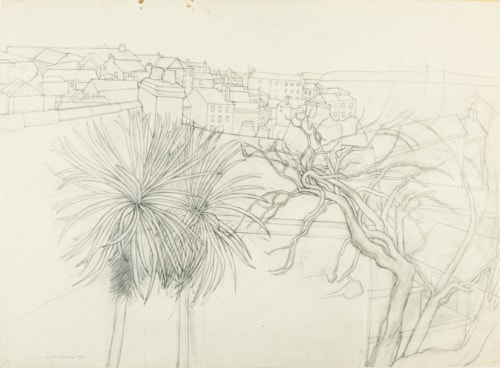
Wilhelmina BARNS-GRAHAM
St. Andrews 1912 - St. Andrews 2004
Biography
The Scottish painter, draughtsman and printmaker Wilhelmina (always known as ‘Willie’ to friends) Barns-Graham was born in St. Andrews in Fife and studied at the Edinburgh College of Art between 1931 and 1937, her tenure sometimes interrupted by recurring health issues caused by weak lungs. While at the College she earned several awards and travel scholarships, and had her work included in the annual Summer Exhibitions of the Royal Scottish Academy. In March 1940, the twenty-seven-year-old artist moved to St. Ives in western Cornwall, where she met Ben Nicholson, Barbara Hepworth and Naum Gabo, as well as the local ‘primitive’ painter Alfred Wallis and the potter Bernard Leach. Barns-Graham was to maintain a studio in St. Ives for the rest of her long career of almost eight decades. In 1942 she became a member of the St. Ives Society of Artists and the Newlyn Society of Artists, exhibiting paintings influenced by Cornish landscapes at both institutions between 1942 and 1949.
After participating in numerous group exhibitions in Cornwall and Edinburgh, Barns-Graham had her first solo exhibition at the Downing Gallery in St. Ives in 1946, followed by a second show there two years later. In 1949 she left the St. Ives Society of Artists and became a founding member of the more progressive breakaway group, the Penwith Society of Artists, where she was to exhibit regularly for the next fifty years. Her work began to be included in group shows in London and she also spent some time in Grindelwald in Switzerland, inspiring a series of paintings, drawings and gouaches of glaciers, executed between 1948 and 1952. In 1950 Barns-Graham’s painting Upper Glacier was acquired by the British Council, and the following year her large painting Porthleven won the St. Ives Festival of Britain prize for painting, while in the same year her work was included in Herbert Read’s book Contemporary British Art.
In 1952 Barns-Graham had her first solo exhibition in London, at the Redfern Gallery. Her travels took her to Paris, Venice and Tuscany, and by 1956 her work was regularly being exhibited in London and she was briefly on the staff of the Leeds School of Art. Although she was fully integrated into the modernist milieu of St. Ives, with the arrival of artists such as Peter Lanyon, Roger Hilton, Terry Frost and Bryan Winter, Barns-Graham often felt at a disadvantage in the competition for recognition and contacts with dealers in London and abroad. She was also unfairly regarded, by some critics and scholars, as a relatively minor member of the St. Ives school. (This imbalance was confirmed when the Tate Gallery’s 1985 exhibition St. Ives 1939-64: Twenty-Five Years of Painting, Sculpture and Pottery included only three works by Barns-Graham, while Lanyon and Hilton were represented by nineteen and twenty paintings, respectively.) In 1960 Barns-Graham began to divide her time between Cornwall and Scotland, having inherited a house near St. Andrews. (She also rented a studio in London between 1961 and 1963.) In St. Ives in 1963 she moved into a studio on Porthmeor Beach, and by the mid 1960s had begun to work in a severely geometrical mode of abstraction, while at the same time continuing to produce representational work, particularly landscapes.
Throughout the 1960s, 1970s and 1980s Barns-Graham’s paintings were shown widely in galleries in Cornwall, London and Scotland, as well as in touring group exhibitions organized by the Arts Council. Although by this time her reputation was largely established as an abstract artist, she continued to paint representational subjects, notably the Cornish landscapes that had been the subject of her first solo exhibitions. (The artist’s landscapes, which later included views of Scotland, Italy and Switzerland, often in turn led to more abstract compositions.) The late 1980s found Barns-Graham producing a vast array of freely-painted, colourful abstract paintings, usually executed on paper rather than canvas, as well as screenprints, which introduced her work to a new audience and market. In 1989 a retrospective exhibition comprising fifty years of her work was held in museums in Penzance, Edinburgh, St. Andrews, Perth and Ayr, followed three years later by another travelling exhibition on the occasion of the artist’s eightieth birthday. As she stated in 2001, the same year that she was awarded a CBE and a major monograph on her work appeared, ‘In my paintings I want to express the joy and importance of colour, texture, energy and vibrancy, with an awareness of space and construction. A celebration of life.’ Barns-Graham continued to produce vibrant paintings and screenprints until her death in January 2004, at the age of ninety-one.



